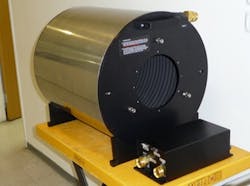North Logan, UT--With the recent appearance of a commercial 100 kW near-IR laser (the 1070-nm-emitting fiber laser developed by IPG Photonics of Oxford, MA), the question arises: How does a user measure the output power of a 100 kW laser? Conventional laser power meters that rely on absorbing surfaces can measure laser powers to 30 kW; however, an output of 100 kW is another thing entirely.
Calorimetric power meter
In response, Ophir Photonics has unveiled a new laser power meter that relies on a calorimetric design to measure beam powers of up to 100 kW. Gary Wagner, general manager of Ophir Photonics, notes that the new 100 kW laser power meter is a fully commercial product, and that the first one is installed at the NADEX Laser R&D Center (Nagoya City, Japan), which needs the Ophir power meter to go along with the IPG Photonics 100 kW fiber laser that it recently purchased for materials-processing use). Engineers at NADEX have already used the Ophir power meter to measure the full output power of the fiber laser (which has its output end mounted on a robot arm).
The Ophir measurement unit itself is barrel-shaped, 300 x 110 x 150 mm in size, and intended to be placed in a diverging beam produced after the focus of a lens with a 500 to 1000 mm focal length. Inside the unit is a highly reflective deflecting cone that receives the beam at approximately 100 mm diameter. The cone deflects the light to the sides of the "barrel," which are lined with a coiled black-absorber-coated copper tube through which water flows; the arrangement traps more than 99% of the laser light. By measuring the volume of water flow and the temperature rise, the laser power dumped into the power meter can be calculated. Linearity is +/-1% or better over a power-level range from 10 to 100 kW, says Ophir.
The unit is calibrated for a 1070 nm wavelength (matching that of the IPG 100 kW fiber laser); this wavelength will make up the majority of applications, says Wagner, although other wavelengths can be calibrated if needed.
With the meteoric rise in fiber-laser powers these days, "we are focusing more and more on high power optics as a company," notes Wagner.
For info on Ophir Photonics, see http://www.ophiropt.com/laser-measurement

